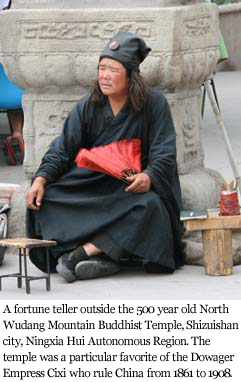
Perhaps more remarkable is the development of new tourist facilities. Sha Hu (Sand Lake) opened in 2000 and has developed into an extremely popular tourist site comprising a large natural lake, and a sandy desert area. It features all the usual attractions popular with Chinese tourists, including quad bikes, jeeps, go-karts, perilous trips in light aircraft, camel rides, and, inevitably, sand sculptures. There are even ostrich rides, although we saw no takers willing to risk getting close to the mangy, vicious looking creatures. Perhaps most importantly the lake's reed islands and surrounding wetlands are home to thousands of wild birds.
The 20 square kilometer Xinghai lake scenic spot, which opened in 2005, was a low lying marshy area that had become a dumping ground for household and commercial waste, filled with mud and silt carried down by the annual flood waters. In 2003 the city government began removing the waste and dredging the mud to form a lake. Today, ten species of wild birds flourish there and wild deer roam the parkland. The lake, exhibition hall and museum attract tens of thousands of visitors per year and are particularly popular with local people. Between the lake and Shizuishan City is a green mountain with tree lined roads, and landscaped gardens – until recently it was a slag heap.
Beiwudangshan (Northern Wudang Mountain) National Park is a huge forest park and tree planting project centered on a 500 year old Buddhist Temple of the same name. The temple was patronized by the Imperial family from Ming times and was a particular favorite of the Qing dowager empress Cixi. The abbot, who used to be a lieutenant in the Peoples Liberation Army, told us there were 20 monks presently in residence. The surrounding area was once desert, but for the past 11 years, cadres, and local people have been planting trees here every spring in a characteristically Chinese, quasi-compulsory activity. The area is irrigated with recycled waste water delivered by Israeli drip-irrigation technology.
Shizuishan's growth is keeping pace with China's boom. In 2007, its GDP reached 16.3 billion yuan, up 14.8 percent from the previous year. Urban disposable income increased by 15.4 percent to 10,536 yuan, and rural average net income went up by 12.8 percent to 4,351 yuan.
A real estate boom has followed in the wake of growing prosperity. Across the suburban areas, new apartment blocks are growing by the dozen. Thickets of cranes sprout on the flatlands near the Yellow River. The average price of apartments has reached 2000 yuan per square meter and top quality blocks fetch as much as 5000. Most of the blocks are under construction or recently completed and not yet occupied but we were assured that there is no shortage of buyers.
With a growing economy and improving environment, large areas of Shizuishan are beginning to look like the kind of modern residential suburbs you can find anywhere in Europe or North America. It is still possible to find pockets of the industrial hell painted by De Spiegel's reporters, but the emerging picture is more 21st century Guildford than 1940s Salford. Of course everyone's idea of hell is different.
(China.org.cn by John Sexton and Pang Li, July 21, 2008)